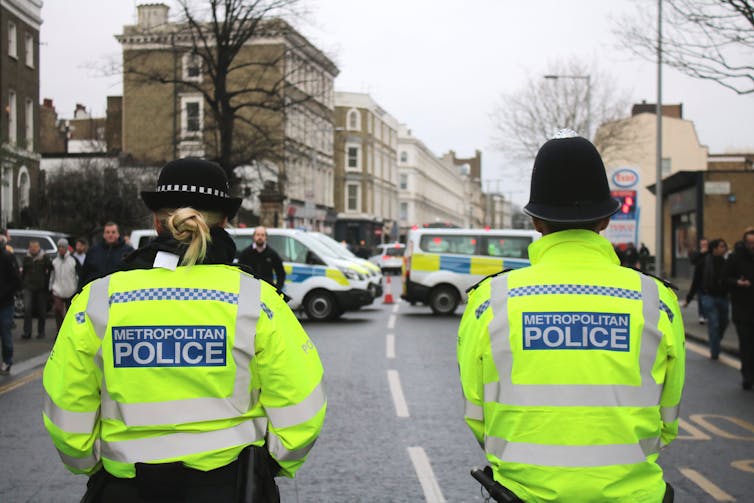Racist abuse at football games is increasing, Home Office says – but the sport's race problem goes much deeper
Daniel Kilvington, Leeds Beckett UniversityFootball-related hate crimes rose 47% in England and Wales during the 2018-19 season, according to Home Office statistics. The number of hate crimes reported at matches jumped from 131 to 193 in just one season, and this recent spike tops a long-running rise in reported incidents over the last seven seasons.
A rise in football racism sadly wouldn’t surprise me. When countries lurch through social and political unrest, racism and xenophobia are rarely far behind. Brexit and the changing political landscape in the US and Europe have seen debates around race, ethnicity and national belonging come to the fore.
But football is changing too. Police are more common at matches than ever before – some of the most heavily policed games feature one officer for every 50 fans. Along with the match-day stewards, fans are also arguably self-policing more than ever before.
Smartphones can capture offences which enable investigations. A reporting app launched in 2015 by Kick It Out – a campaign to end discrimination of all kinds in the sport – has allowed football fans who’ve witnessed discrimination in the stands to report it anonymously. A number of professional clubs have developed their own reporting app.
So, is racism getting worse? Or, are fans just reporting it more than ever before?

Racist abuse is moving online
Let’s place these numbers in context. Racist incidents were reported at 152 out of a total of 3,022 matches during the 2018-19 season. Incidents of racist chanting occurred in just 0.5% of all matches – a slight decrease from the previous season.Racism at games is worrying, but it could be that the Home Office’s report overlooks much more pervasive hate speech online. Less than two months into the new football season and Paul Pogba, Tammy Abraham and Marcus Rashford had all encountered racist abuse on Twitter after missing penalties.
Kick It Out reported 22,000 discriminatory online posts directed at players and teams during the European Championships in 2016. During the 2014/15 English Premier League season, approximately 134,400 discriminatory posts were aimed at players and clubs. That’s an average of 16,800 discriminatory posts every month. In both pieces of research, racism was the most common form of hate speech.
Thanks to the Home Office – which uses parliamentary questions and freedom of information requests – we know how many fans were arrested for racist and indecent chanting in the 2018-19 season. But the report offers no mention of online abuse aimed at players, fans and clubs.
While the Football Association (FA) liaises with Kick It Out to deal with racism and discrimination in football stadiums, it doesn’t involve itself with incidents on social media which are flagged by Kick It Out. The FA, Kick It Out, the Professional Footballers’ Association (PFA) and professional clubs should cooperate to challenge online abuse and develop policies to protect and support people targeted online.
Collecting timely and comprehensive evidence of online abuse will help authorities understand how serious the issue is and pressure them to act. The Home Office can help by devoting more resources to investigating online abuse as well as match-day abuse in stadiums.
The ugly side of the beautiful game
Overt forms of discrimination are easy to spot and report, but it isn’t clear that as much attention is being paid to institutional forms of racism. The structural and institutional barriers that prevent Black, Asian and Minority Ethnic (BAME) groups from enjoying football are just as pervasive.My research has explored how institutionalised barriers have excluded British Asian footballers from the professional game. Historically, the recruitment system in football has relied on “white-to-white” networks and scouts, which have traditionally visited the same leagues, clubs and tournaments to find players. This system has worked to exclude British Asian footballers, as many players compete in predominantly British Asian teams or unaffiliated spaces, such as five-a-side leagues.
As a result, British Asian role models are underrepresented. My work has also highlighted that some scouts and coaches perceive British Asian players as a “gamble”, while others simply refuse to visit predominantly British Asian clubs to find players. Islamophobia in grassroots and semi-professional football also limits opportunities for young children in certain areas of the country. Together, this system has lost football decades of talent.
Read more: British Asians and football: how the 'beautiful game' needs to change
If racism is only understood as a visible phenomenon, its decline in physical spaces such as sports stadiums will be taken as evidence that it has gone away entirely. While much abuse migrates online, the time has also come to comprehend racism as a structural problem within the institutions of football.
There is one positive – people are talking about racism more. More racism is being reported whenever it appears and we, the fans, can all play our part in making sure the beautiful game can be enjoyed by everyone.
Daniel Kilvington, Senior lecturer in Media and Cultural Studies, Leeds Beckett University
This article is republished from The Conversation under a Creative Commons license. Read the original article.
No comments:
Post a Comment